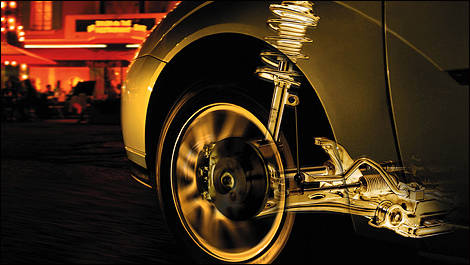Suspension connects a vehicle's unsprung masses (wheels and brakes) to the chassis and cabin. It uses three key components: linkage (A-arms, struts), a support assembly (coil springs, torsion beam, etc.), and a damper (shock absorber).
There are three main vehicle suspension setups: independent, semi-independent, and solid axle. Of course, automakers can use different setups in the front and back.
Let's take a closer look.
Suspension is designed to support the weight of the vehicle, improve comfort by soaking up road imperfections, maximize handling, and reduce vibrations.
Impact is absorbed both by the springs and shocks. The latter use either gas or oil to create a resistance that mitigates rebound.
Suspension setups
Independent: Offering the best handling, this setup has no direct link between the left and right sides of the vehicle other than a stabilizer bar. With a few exceptions, nearly all modern cars use an independent front suspension. Most of them use one in the back, save for some low-price models and full-size pickup trucks. It's the most sophisticated suspension design, but also the most expensive to produce. Example: Subaru BRZ (all four wheels).
Semi-independent: This setup is similar to a solid axle, except that the torsion beam which connects the lower ends is softer. Cost savings justify its use. Example: Toyota Yaris (rear wheels).
Solid axle: This setup can be found in the back, where it provides superior rigidity and ruggedness. Vehicles designed for heavy towing or serious off-roading sometimes rely on both front and rear solid axles. Example: Ford F-150 (rear wheels).
Linkage
Struts: The shock absorber and spring are linked to the chassis by a single point. Example: Subaru Impreza WRX STI.
Double wishbones: Wishbones (also known as A-arms) are used in combination: one down low, and another one higher up. It improves camber control and wheel alignment at all times. Example: Nissan 370Z (rear wheels).
Multiple links: What stands out here is the number of pivot points. Handling is optimized as a result. Nowadays, most cars feature this kind of linkage in the back, especially those with rear-wheel drive. Example: BMW 128i (rear wheels).
Various materials can be used for these links. Steel is the most cost-effective, and therefore the most popular. Aluminum is lighter, but costs about twice as much.
Support
Coil springs: These springs are the most common in today's world. They can be used as part of a coilover suspension like the MacPherson strut, which usually carries both the spring and shock absorber on a single axis. It's a simple, compact and lightweight design that proves relatively cheap to build. Coil springs can also be used independently from the shock absorbers.
Leaf springs: Here, the spring and shock absorber are replaced with a number of steel blades, or leaves, in various lengths. They are put on top of each other to form an upside down pyramid. The ends are attached to the frame, and the middle section is often attached to a solid axle (next to the wheel).
Longitudinal torsion beam: This solid beam supports the two wheels on the same side, so it essentially runs the length of the wheelbase. It provides extra strength when one of the wheels takes a hit.
Lateral torsion beam: This arc-shaped blade connects the left and right rear suspensions to the chassis.
Hydropneumatic suspension: Springs are replaced with air chambers or oil-filled cylinders. It's a pretty expensive setup, but it allows for accurate ride height adjustment for numerous applications such as off-roading and sporty driving.
Added bonus
All vehicles also feature one or several stabilizer bars to reduce weight transfers and that undesirable body roll from side to side.
There are three main vehicle suspension setups: independent, semi-independent, and solid axle. Of course, automakers can use different setups in the front and back.
Let's take a closer look.
Suspension is designed to support the weight of the vehicle, improve comfort by soaking up road imperfections, maximize handling, and reduce vibrations.
Impact is absorbed both by the springs and shocks. The latter use either gas or oil to create a resistance that mitigates rebound.
 |
| Photo: Ford |
Suspension setups
Independent: Offering the best handling, this setup has no direct link between the left and right sides of the vehicle other than a stabilizer bar. With a few exceptions, nearly all modern cars use an independent front suspension. Most of them use one in the back, save for some low-price models and full-size pickup trucks. It's the most sophisticated suspension design, but also the most expensive to produce. Example: Subaru BRZ (all four wheels).
Semi-independent: This setup is similar to a solid axle, except that the torsion beam which connects the lower ends is softer. Cost savings justify its use. Example: Toyota Yaris (rear wheels).
Solid axle: This setup can be found in the back, where it provides superior rigidity and ruggedness. Vehicles designed for heavy towing or serious off-roading sometimes rely on both front and rear solid axles. Example: Ford F-150 (rear wheels).
Linkage
Struts: The shock absorber and spring are linked to the chassis by a single point. Example: Subaru Impreza WRX STI.
Double wishbones: Wishbones (also known as A-arms) are used in combination: one down low, and another one higher up. It improves camber control and wheel alignment at all times. Example: Nissan 370Z (rear wheels).
Multiple links: What stands out here is the number of pivot points. Handling is optimized as a result. Nowadays, most cars feature this kind of linkage in the back, especially those with rear-wheel drive. Example: BMW 128i (rear wheels).
Various materials can be used for these links. Steel is the most cost-effective, and therefore the most popular. Aluminum is lighter, but costs about twice as much.
Support
Coil springs: These springs are the most common in today's world. They can be used as part of a coilover suspension like the MacPherson strut, which usually carries both the spring and shock absorber on a single axis. It's a simple, compact and lightweight design that proves relatively cheap to build. Coil springs can also be used independently from the shock absorbers.
Leaf springs: Here, the spring and shock absorber are replaced with a number of steel blades, or leaves, in various lengths. They are put on top of each other to form an upside down pyramid. The ends are attached to the frame, and the middle section is often attached to a solid axle (next to the wheel).
Longitudinal torsion beam: This solid beam supports the two wheels on the same side, so it essentially runs the length of the wheelbase. It provides extra strength when one of the wheels takes a hit.
Lateral torsion beam: This arc-shaped blade connects the left and right rear suspensions to the chassis.
Hydropneumatic suspension: Springs are replaced with air chambers or oil-filled cylinders. It's a pretty expensive setup, but it allows for accurate ride height adjustment for numerous applications such as off-roading and sporty driving.
Added bonus
All vehicles also feature one or several stabilizer bars to reduce weight transfers and that undesirable body roll from side to side.


